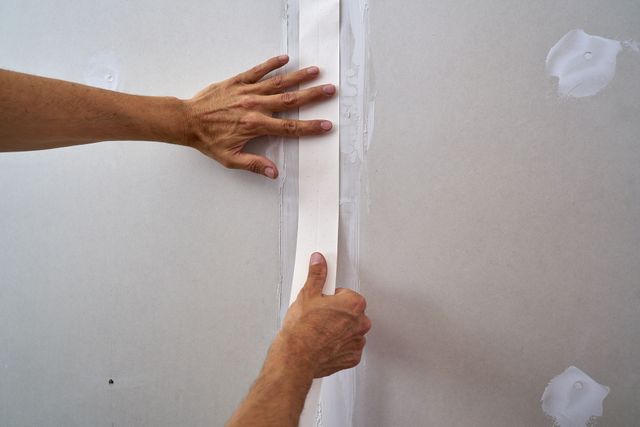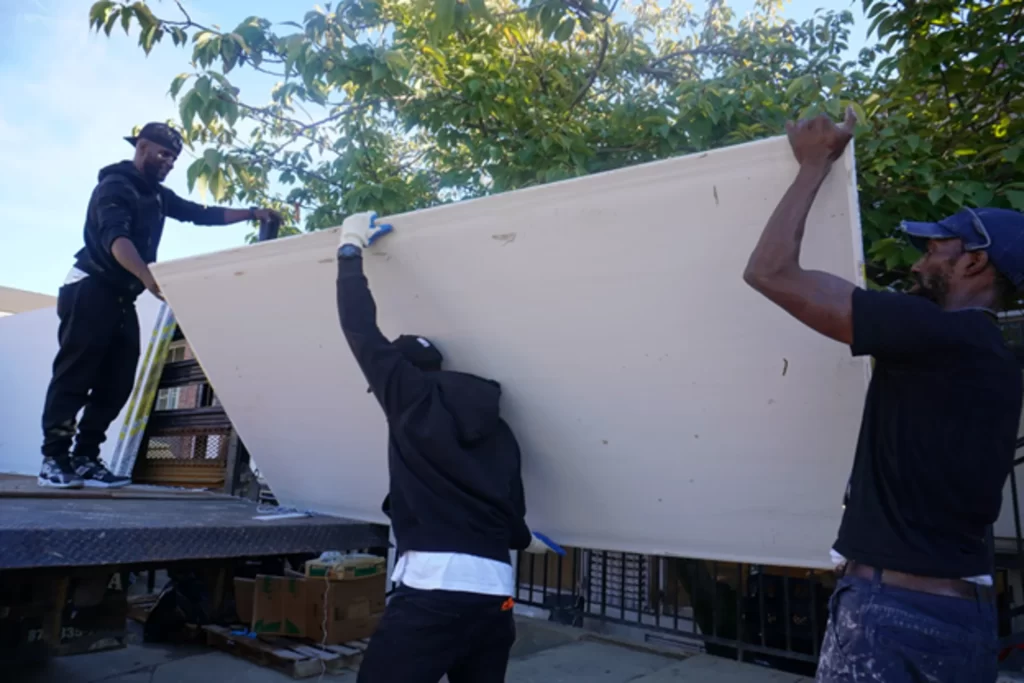Discover the benefits of hiring skilled drywall contractors for your next Interior Painting project.
Important Tips for Effective Drywall Repair and Installation Methods
Efficient drywall repair service and installment needs a mindful strategy. Comprehending the sorts of drywall and having the right devices is essential. Appropriate strategies and exact dimensions can considerably influence the end result. Many overlook important actions like taping and sanding, which can make or damage the last appearance. As tasks proceed, common obstacles may emerge that require attention. Discovering these tips can bring about a much more successful and sleek surface.
Recognizing Different Sorts Of Drywall
Recognizing the various sorts of drywall is essential for any effective repair work or installment task. Drywall, typically called plaster board, can be found in numerous varieties customized for specific applications. Criterion drywall is one of the most widely made use of kind, suitable for general indoor wall surfaces and ceilings. Moisture-resistant drywall, commonly green in color, is designed for areas susceptible to moisture, such as cooking areas and restrooms. Fireproof drywall, generally colored pink or purple, is engineered to withstand higher temperatures and is often utilized in garages or near furnaces. Additionally, soundproof drywall helps in reducing noise transmission, making it ideal for multi-family homes or recording studios. Specialty drywall, like concrete board, is made use of in damp areas like showers or tub borders. Recognizing these kinds assists in selecting the right product for each and every project, making sure longevity and efficiency out of commission or brand-new setups.
Important Tools for Drywall Fixing and Setup
Having the right devices is necessary for efficient drywall repair and installation. A quality utility blade is essential for reducing drywall sheets precisely. A drywall T-square aids guarantee straight sides, while a taping knife is essential for using joint compound smoothly over joints. In addition, a drywall saw permits for cutting out damaged areas or fitting drywall around components.
For hanging drywall, a power drill with drywall screws is crucial, as it makes it possible for fast and safe installation. A degree is additionally vital to verify that the drywall is straight and correctly straightened. A sanding block or pole sander is vital for raveling joint compound once it has dried out. A measuring tape is vital for accurate measurements, stopping waste and ensuring an appropriate fit. Equipped with these tools, people can take on drywall projects efficiently, leading to professional-looking outcomes.
Step-by-Step Overview to Repairing Holes and Cracks
When resolving holes and splits in drywall, having the right tools and products is important for an effective repair. This guide lays out the required products and supplies a clear, step-by-step procedure to effectively bring back the surface. Recognizing these aspects will certainly aid guarantee a smooth surface and resilient outcomes.
Devices and Products Needed
A well-appointed toolkit is essential for effective drywall repair work and setup. Key tools include an utility knife for cutting drywall, a measuring tape to ensure accurate sizing, and a drywall saw for bigger openings. A putty blade is necessary for using joint compound smoothly, while a fining sand block or post sander assists achieve a seamless coating. For patching, a roll of fiberglass harmonize tape or paper tape is required to strengthen joints. Furthermore, a drill and screws are needed for safeguarding brand-new drywall items. Essential materials include joint substance, primer, and paint to complete the repair work. Having these tools and products handy assures a smoother, this contact form extra reliable repair service process, yielding professional-looking outcomes.
Repair Service Refine Steps
Repairing openings and cracks in drywall calls for a methodical approach to ensure a seamless surface. The area surrounding the damages needs to be cleansed completely to remove dust and particles. Next off, for small fractures, a putty blade is made use of to apply a joint substance evenly over the area. For larger holes, a patch is necessary; the damaged area is eliminated, and a new item of drywall is fitted in location, secured with screws. When the spot is in position, joint compound is put on mix the edges. After drying out, fining sand the location smooth is important. The fixed surface should be keyed and repainted to match the bordering wall, ensuring a low-profile repair work.
Methods for Installing Drywall Panels
Installing drywall panels calls for cautious planning and precise implementation to guarantee a smooth and expert coating. It is vital to determine the wall space accurately and cut the panels to fit, guaranteeing that they line up with the studs. Placing the panels horizontally is generally recommended, as this can boost the structural honesty and decrease the number of joints.
Making use of drywall screws, installers ought to protect the panels every 16 inches along the studs, making sure a company hold. It is essential to stay clear of overdriving the screws, which can harm the paper surface area. For edges and edges, using an utility blade allows for clean cuts and a tight fit.

Finishing Touches: Taping, Mudding, and Sanding
As soon as the drywall panels are securely in location, the following important step involves the finishing touches of taping, mudding, and sanding. Insulation is vital for producing a smooth change in between panels and hiding joints. A high quality drywall tape, either paper or fiberglass harmonize, should be applied over the joints, ensuring straight from the source it sticks effectively to the mud that will be applied following.
Mudding, or applying joint substance, adheres to the taping process. This substance fills up spaces and ravel the surface area. A first coat should be applied generously, feathering the edges to blend with the drywall. After the initial layer dries out, succeeding layers may be required for a flawless finish.
Fining sand is necessary to achieve a smooth surface. A fine-grit sandpaper ought to be utilized Going Here to carefully ravel any type of flaws. Care ought to be taken to prevent over-sanding, which can damage the drywall - Drywall Installation Ogden Utah. Correctly implemented, these ending up touches develop a professional appearance prepared for painting
Tips for Maintaining Your Drywall After Installment
Preserving drywall after setup is essential to preserving its look and structural stability. Regular cleansing is essential; dirt and dust can gather, so gentle cleaning with a wet towel is advised. Property owners ought to also check for any type of indicators of dampness or mold, specifically in high-humidity locations like shower rooms and cooking areas. If any type of damage takes place, it's crucial to resolve it promptly to stop further concerns.
Using furniture pads can aid avoid scrapes or damages from heavy products. Furthermore, painting the drywall with a top notch, washable paint gives an added layer of protection and makes future cleansing less complicated. Avoid using abrasive cleansers or devices, as these can harm the surface area. Maintaining a steady interior climate with appropriate moisture levels will certainly assist avoid buckling or splitting over time. By complying with these pointers, one can guarantee that drywall stays in exceptional condition for many years ahead.
Often Asked Concerns
For How Long Does Drywall Require To Fully Dry After Setup?

Can I Install Drywall Over Existing Drywall?
Yes, drywall can be mounted over existing drywall, but it is crucial to ensure the underlying surface is secure and sufficiently prepared. This method can enhance insulation and lower installation time, though it may add weight.
What Is the most effective Way to Soundproof Drywall?
The finest means to soundproof drywall involves utilizing specialized soundproofing products, such as resistant channels, acoustic caulk, and sound-dampening drywall. These strategies efficiently lessen audio transmission between areas, enhancing total acoustic performance in living spaces.
Exactly how Do I Select the Right Drywall Density?
To choose the right drywall thickness, consider the application and place. Requirement household wall surfaces usually utilize 1/2 inch, while ceilings or specialized locations might call for 5/8 inch for extra toughness and soundproofing capabilities.
Are There Eco-Friendly Drywall Options Available?
Yes, environmentally friendly drywall choices are readily available. These consist of products made from recycled products, plaster boards with reduced unstable organic substances (VOCs), and those using sustainable manufacturing procedures, using environmentally-conscious options for building and restoration tasks.
Having the right tools is necessary for reliable drywall repair and installation. For hanging drywall, a power drill with drywall screws is vital, as it makes it possible for quick and protected setup. Trick devices consist of an utility knife for reducing drywall, a tape step to ensure precise sizing, and a drywall saw for larger holes. Yes, drywall can be mounted over existing drywall, but it is vital to assure the underlying surface area is safe and effectively prepared. The best method to soundproof drywall involves making use of specialized soundproofing products, such as durable networks, acoustic caulk, and sound-dampening drywall.